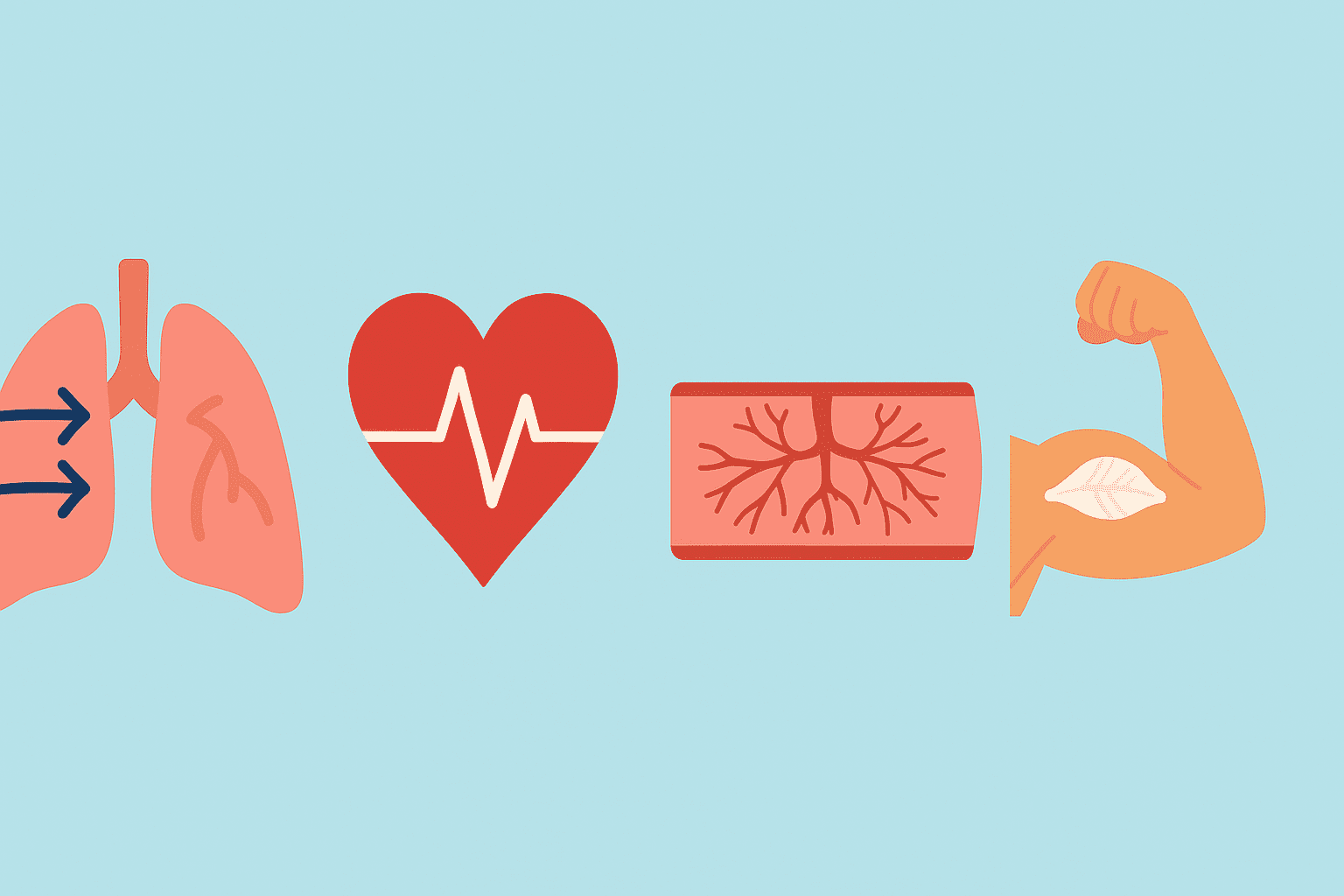Introduction: Understanding the Power of Cardiovascular Training
In the realm of health and performance, few topics are as foundational yet misunderstood as cardiovascular exercise. While many people engage in cardio to burn calories or lose weight, the deeper benefits of cardiovascular workouts extend far beyond the scale. From optimizing heart health to enhancing muscular efficiency and even improving mental clarity, the physiological effects of cardio training are vast and significant. But what does cardiovascular exercise mean, and why is it a cornerstone of peak performance and endurance development? To answer these questions, we must go beyond surface-level assumptions and unpack the cardiovascular exercise definition, its various forms, and how they serve as critical tools in enhancing human vitality.
When people ask, “What is cardio?” or “What is considered cardio exercise?” they’re often looking for guidance on the most effective ways to move, sweat, and build stamina. Yet the definition of cardio workout is more comprehensive than a run on the treadmill or a cycling session. It encompasses any activity that elevates the heart rate, improves oxygen transport, and enhances the efficiency of the cardiovascular and respiratory systems. In this article, we will explore different types of cardio, the meaning of cardiovascular fitness, and why integrating various forms of cardio into your routine can transform not just your physical endurance but your overall well-being.
You may also like: Smart Nutrition Choices for a Healthier Lifestyle: What to Know About Whole Grain Rice and Whole Wheat Rice

What Does Cardiovascular Exercise Mean? A Foundational Definition
At its core, cardiovascular exercise refers to any physical activity that raises your heart rate and keeps it elevated for an extended period. The cardiovascular exercise meaning stems from its direct engagement with the heart, lungs, and circulatory system. The term “cardio” is a shorthand for cardiovascular, emphasizing the primary systems being targeted. When you define cardiovascular exercise, you are essentially referring to movement that strengthens the heart, enhances lung capacity, and promotes efficient blood flow throughout the body.
So what does cardio exercise mean in practical terms? It means engaging in activities that challenge your heart and lungs in a sustained way. Whether you’re jogging through your neighborhood, swimming laps in a pool, or dancing through a high-intensity Zumba class, you’re participating in a cardiovascular workout. These forms of exercise elevate the demand on your body to supply oxygen to your muscles, which improves both aerobic capacity and cardiorespiratory fitness.
The cardiovascular workout definition also includes a focus on frequency and intensity. To be considered effective, a cardio workout should last at least 20–30 minutes and reach a moderate to vigorous intensity level. This helps achieve improvements in cardiovascular health markers such as resting heart rate, blood pressure, and cholesterol levels. Therefore, understanding the cardiovascular exercise definition is not just about knowing what movements qualify—it’s about recognizing their physiological impacts and how they align with your health and performance goals.

Different Types of Cardio and Their Unique Benefits
One of the most compelling aspects of cardiovascular training is the wide range of activities that fall under its umbrella. The different types of cardio available make it an accessible and versatile option for nearly every fitness level and personal preference. From low-impact options to high-intensity regimens, the diversity of cardiovascular exercise types ensures that there is something for everyone.
Commonly practiced forms include running, cycling, swimming, rowing, and brisk walking. These are often cited as classic examples of cardiovascular workouts due to their rhythmic nature and extended duration. Yet there are many different forms of cardio exercise that go beyond these staples. Dancing, jumping rope, hiking, and even vigorous yard work can all be classified as cardio when performed with enough intensity. These diverse activities make it easy to engage in cardiovascular fitness without feeling stuck in a routine.
Each of these types of cardiovascular exercise offers unique physiological and psychological benefits. Swimming, for instance, is an excellent low-impact option for individuals with joint pain, while rowing targets both the upper and lower body muscles for a full-body cardio challenge. Interval-based activities such as High-Intensity Interval Training (HIIT) provide a time-efficient way to boost cardiovascular endurance and metabolic rate. By incorporating different types of cardio into your routine, you challenge your body in new ways, prevent plateaus, and improve overall functional fitness.

Why Cardiovascular Fitness Matters for Peak Performance
The cardiovascular fitness definition revolves around the ability of the heart, lungs, and circulatory system to supply oxygen during sustained physical activity. For athletes and everyday exercisers alike, this ability translates directly to performance outcomes. Whether you’re training for a marathon, playing a team sport, or simply striving to complete your daily routine with more ease, cardiovascular endurance is key.
So what does cardio workout mean in the context of performance? It means more efficient energy production, greater stamina, and faster recovery. As the body adapts to repeated cardiovascular stress, it increases mitochondrial density, improves stroke volume (the amount of blood pumped per heartbeat), and enhances oxygen delivery to working muscles. These adaptations directly influence your capacity to perform at a higher level over longer periods.
Moreover, cardiovascular workouts are essential for heart health, one of the most critical components of lifelong vitality. Regular cardio training has been shown to reduce the risk of heart disease, stroke, type 2 diabetes, and even some forms of cancer. These health benefits underline the importance of including cardio in any performance enhancement plan. Understanding what is cardio exercise definition helps demystify its role and emphasizes its non-negotiable importance in a well-rounded training program.

Examples and Activities That Build Cardiovascular Endurance
If you’re wondering what is considered cardiovascular exercise, the answer lies in its ability to elevate and maintain heart rate over time. Activities that build cardiovascular endurance include both steady-state and interval formats, provided they push the cardiorespiratory system into a state of increased demand. Some cardio endurance examples include long-distance running, cycling tours, uphill hiking, swimming multiple laps, and rowing over extended periods.
When looking for effective cardiorespiratory fitness workouts, consider activities that incorporate large muscle groups in continuous motion. These exercises are especially effective at improving stroke volume and cardiac output. Brisk walking for 45 minutes, for instance, can offer measurable improvements in cardiovascular endurance, especially when done consistently. Over time, the heart becomes more efficient, and oxygen delivery becomes more reliable, even during non-exercise activities.
Understanding the definition of cardiovascular training also reveals the role of progression and variety. As your fitness improves, so should the intensity or duration of your cardiovascular workouts. This principle of progressive overload applies to endurance training just as it does to strength training. By pushing yourself slightly further each week—whether that means increasing speed, distance, or resistance—you continue to stimulate adaptations that enhance your cardiovascular workout meaning and overall fitness level.

Exploring the Physiology Behind Cardio’s Effectiveness
To truly appreciate the meaning of cardiovascular fitness, one must delve into the physiological responses it elicits. Cardiovascular exercise causes a cascade of responses in the body, starting with an elevated heart rate and increased respiration. As muscles contract repetitively, they demand more oxygen, prompting the heart to pump faster and the lungs to work harder. Over time, these acute responses become chronic adaptations that redefine your body’s performance baseline.
Key markers of improved cardiovascular health include lower resting heart rate, reduced blood pressure, improved VO2 max (the maximum amount of oxygen the body can utilize), and better metabolic flexibility. These adaptations are not limited to elite athletes—they are achievable for anyone who commits to regular cardiovascular activity. Thus, when considering what is considered as cardio or seeking to define cardio workout in a meaningful way, the science behind these changes reinforces cardio’s central role in physical conditioning.
The cardiovascular activity definition also includes the body’s enhanced ability to clear metabolic waste and regulate blood sugar levels. This means more efficient fuel usage and improved endurance over time. Additionally, increased capillary density ensures better nutrient delivery to muscles, promoting faster recovery and more effective energy production. The more consistent your cardio practice, the more pronounced these benefits become.
Designing a Sustainable Cardio Training Plan
Incorporating different forms of cardio into a personalized training plan is essential for sustaining progress and avoiding burnout. A balanced routine might include a mix of steady-state sessions for endurance, interval workouts for intensity, and recreational activities for enjoyment and variety. This diversity supports both the definition of cardiovascular training and the long-term adherence needed for lasting results.
When building your schedule, consider your fitness level, goals, and available time. Beginners might start with walking or light cycling three times a week, while advanced exercisers may include five or more sessions that alternate between aerobic and anaerobic intensities. The goal is not just to boost cardio but to do so in a way that aligns with your lifestyle and capacity.
It’s also crucial to incorporate recovery strategies, such as sleep, hydration, and mobility work, into your program. These practices allow the cardiovascular system to recover and adapt, making each workout more effective. Ultimately, the cardiovascular workout meaning expands when viewed in the context of overall wellness, not just calorie expenditure or time spent in the gym.

How Cardio Supports Mental Health and Cognitive Function
Cardio’s benefits are not limited to the physical realm. One of the lesser-known advantages of cardiovascular workouts is their profound impact on mental health and brain performance. Studies have shown that regular cardio exercise reduces symptoms of anxiety and depression, improves mood regulation, and enhances focus and cognitive flexibility. These outcomes add yet another layer to the question of what does cardiovascular exercise mean in real-world terms.
During cardio, the body releases endorphins—natural chemicals that promote a sense of well-being. At the same time, increased blood flow to the brain supports neurogenesis, the creation of new brain cells. This process improves memory, decision-making, and overall cognitive function. The definition of cardio workout, then, extends far beyond the body’s ability to move—it includes the mind’s capacity to thrive.
Moreover, cardiovascular exercise can help regulate the body’s stress response by lowering cortisol levels and promoting better sleep patterns. These psychological benefits are especially important in today’s high-stress world. When we discuss different types of cardio and their importance, we must also acknowledge that the emotional and psychological gains are just as vital as the physical ones.
Frequently Asked Questions: Advanced Insights into Cardiovascular Exercise
1. How can I diversify my cardio routine without compromising progress? Diversifying your cardio routine is essential not only to avoid physical plateaus but also to stimulate different energy systems and muscle groups. Integrating different types of cardio such as swimming, cycling, and hiking introduces varied mechanical and metabolic demands on the body. These activities promote well-rounded cardiovascular adaptations while keeping motivation high. Exploring different forms of cardio exercise like dance-based workouts or martial arts adds a layer of neuromuscular complexity, challenging coordination and mental focus. This strategy ensures that your cardiovascular fitness continues to progress while keeping your workouts fresh, fun, and mentally engaging.
2. What does cardiovascular exercise mean for someone with a sedentary lifestyle? For individuals transitioning from a sedentary lifestyle, understanding what does cardiovascular exercise mean takes on a transformative significance. It isn’t solely about fitness but also about reclaiming metabolic function, improving insulin sensitivity, and reconditioning the heart muscle. Starting with low-intensity activities such as walking or aquatic aerobics—considered gentle types of cardiovascular exercise—can lay the foundation for gradual improvement. These early efforts, when sustained, evolve into more intense cardiorespiratory fitness workouts that yield noticeable improvements in energy, mood, and sleep. Over time, these foundational activities redefine the cardiovascular workout meaning, demonstrating how modest beginnings can evolve into life-changing habits.
3. How does the definition of cardiovascular training change in athletic versus clinical populations? The definition of cardiovascular training varies significantly depending on context. For athletes, the focus is often on enhancing VO2 max, lactate threshold, and power output through strategic manipulation of intensity and recovery periods. In contrast, for clinical populations managing conditions like hypertension or heart disease, the goal of cardiovascular exercise meaning lies in achieving functional capacity, reducing cardiac workload, and restoring vascular health. What is considered as cardio for a patient in cardiac rehab—such as slow treadmill walking—differs greatly from high-volume interval running used in competitive training. However, both examples of cardiovascular activity are valid and tailored to their respective goals, highlighting the versatility of cardiovascular workout definition.
4. What role does heart rate variability (HRV) play in interpreting cardio effectiveness? Heart rate variability has emerged as a valuable marker for assessing recovery and cardiovascular stress. A higher HRV typically indicates a well-recovered state and adaptability to stress, which correlates positively with cardiovascular fitness definition. Monitoring HRV can help individuals adjust their training load more precisely, ensuring they avoid overtraining while maximizing gains. Understanding the cardiovascular exercise definition through the lens of HRV allows athletes to fine-tune their cardio endurance examples based on readiness rather than rigid schedules. As a feedback tool, HRV supports a more intelligent, personalized approach to defining cardio workout success.
5. Are certain forms of cardio better suited for cognitive performance? Yes, some types of cardio have been shown to be particularly beneficial for brain health. Rhythmic and repetitive movements found in steady-state running or cycling often enhance neuroplasticity and executive function. These forms fall under what is considered cardiovascular exercise, as they stimulate consistent blood flow to the brain and improve oxygen delivery. Emerging research also shows that different types of cardio, such as dance or boxing, may provide dual-task benefits by combining physical effort with cognitive engagement. This adds another layer to the meaning of cardiovascular fitness, where the mind and body benefit simultaneously from strategic aerobic interventions.
6. How does climate affect the outcome of cardiovascular training? Environmental factors like heat, cold, and altitude significantly influence how the body responds to different forms of cardio. Exercising in high temperatures increases cardiovascular strain, requiring the heart to pump harder to facilitate thermoregulation. Cold weather, meanwhile, may reduce muscle elasticity and increase energy expenditure, altering the definition of cardio workout in terms of perceived exertion and performance outcomes. High-altitude environments challenge oxygen delivery, making even simple activities cardiovascular endurance tasks. These conditions redefine what is considered as cardio and add valuable context to how cardiovascular exercise meaning should be interpreted in diverse training environments.
7. Can strength training count as cardio if done in a certain way? Under specific circumstances, strength training can elicit cardiovascular benefits, particularly when performed in circuit style or using compound movements with minimal rest. This hybrid approach blurs the lines between traditional resistance workouts and the definition of cardiovascular training. For instance, a kettlebell complex or CrossFit-style WODs challenge both muscular endurance and heart rate control. While not all strength sessions meet the cardiovascular workout meaning, these high-volume, short-rest formats do qualify as cardiorespiratory fitness workouts when sustained over time. Thus, they serve as unconventional but effective examples of cardiovascular activity for those seeking functional variety.
8. How can individuals with mobility limitations participate in cardio training? Mobility challenges need not preclude cardiovascular exercise. Adaptive types of cardiovascular exercise include seated aerobics, arm ergometry, or water-based training, each of which meets the definition of cardio workout when intensity and duration are sufficient. These options make it possible for individuals with physical limitations to engage in meaningful activities cardiovascular endurance can be built upon. Even passive-assisted modalities, such as motorized recumbent cycling, can improve circulation, heart rate variability, and aerobic capacity. Such adaptations broaden the definition of cardiovascular exercise and make it more inclusive, affirming that cardio is a universal modality adaptable to nearly every physical condition.
9. How can someone accurately assess improvements in cardiovascular fitness beyond weight loss? Weight loss is often mistakenly used as the primary measure of fitness progress, but it doesn’t capture improvements in heart function or stamina. Better metrics include improvements in resting heart rate, blood pressure, and perceived exertion during standardized efforts. Individuals can also track specific cardio endurance examples like time-to-exhaustion during treadmill tests or reduced recovery time post-exercise. These indicators reflect the evolving meaning of cardiovascular fitness and demonstrate functional gains that aren’t always visible on the scale. Understanding how to define cardiovascular exercise outcomes using diverse physiological markers helps create a more complete and motivating feedback loop.
10. What are future trends in cardiovascular workout technology and training? Advancements in wearable technology and AI-driven platforms are redefining how we approach cardiovascular workout meaning. Real-time biofeedback, predictive performance modeling, and personalized programming are becoming more accessible through smart devices and apps. These tools can suggest different forms of cardio exercise based on daily recovery, stress levels, and even sleep quality. This level of customization supports not just performance but also long-term adherence and motivation. As we continue to explore what is cardio in both scientific and practical contexts, the evolution of cardiovascular training technologies promises more intelligent, effective, and engaging fitness journeys.
Conclusion: Embracing Cardio for a Stronger, Healthier Future
So what is cardio, really? It’s more than a treadmill session or a fitness trend. It is a scientifically grounded method of enhancing heart function, respiratory capacity, muscular endurance, and even mental health. Understanding what does cardio workout mean, in all its dimensions, empowers individuals to make informed choices that align with their performance goals and long-term well-being.
The various types of cardiovascular exercise—from running and swimming to dancing and rowing—offer both accessibility and effectiveness. Each example of cardiovascular effort contributes uniquely to the definition of cardiovascular training, highlighting the importance of variation and consistency. Whether you’re an elite athlete or just starting your fitness journey, embracing the cardiovascular workout definition in its fullest sense can help you unlock your highest potential.
By recognizing what is considered as cardio, learning how to boost cardio performance, and appreciating the meaning of cardiovascular fitness, you build a foundation that supports both endurance and heart health. And in doing so, you’re not just moving—you’re evolving. With every breath, every step, and every heartbeat, you’re sculpting a stronger, healthier version of yourself, one that’s ready to thrive in every aspect of life.
Was this article helpful? Don’t let it stop with you. Share it right now with someone who needs to see it—whether it’s a friend, a colleague, or your whole network. And if staying ahead on this topic matters to you, subscribe to this publication for the most up-to-date information. You’ll get the latest insights delivered straight to you—no searching, no missing out.

